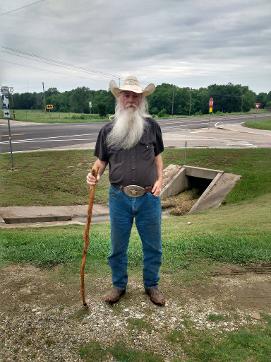GOD'S WORD
The Stories of Mesha Stele, Hadadezer and Sanballat I
"The Introduction!" A Four Part Series"
March 21, 2024

Reverend Danny Rhoades
Brothers and sisters, I'm doing something different over the next four days. I will be doing a Four Part Series on "The Stories of Mesha Stele, Hadadezer and Sanballat I, in the KJV Bible. What rolls did they play in it and why were they important? I do hope the you will gain some great knowledge from them.
Today's devotional we will be delving into Part One "The introduction to the Mesha Stele, Hadadezer, and Sanballat I," and learn why they are intriguing figures woven into the tapestry of the King James Version (KJV) Bible, each playing a distinct role in shaping the narratives of ancient times.
These historical characters offer insights into the political landscape, conflicts, and alliances of their era, providing valuable context for understanding the
events depicted in the scriptures. By delving into the stories of Mesha Stele, Hadadezer, and Sanballat I, we can unravel the significance of their actions and the impact they had on biblical events, shedding light on the complexities of the ancient world and the enduring relevance of their stories in contemporary interpretations of the KJV Bible.
In the pages of the KJV Bible, we encounter intriguing figures such as Mesha Stele, Hadadezer, and Sanballat I. These characters play significant roles in biblical narratives, each contributing to the rich tapestry of stories found within the scriptures.
To truly appreciate the stories of Mesha Stele, Hadadezer, and Sanballat I in the KJV Bible, it is essential to delve into the historical backdrop in which these events unfolded. Understanding the political, social, and religious dynamics of the time sheds light on the relevance and importance of these characters in biblical narratives.
Overview of Mesha Stele, Hadadezer, and Sanballat I
Mesha Stele, Hadadezer, and Sanballat I are key figures whose actions and interactions with biblical characters have lasting impacts. From conflicts and opposition to alliances and rebuilding efforts, each character brings a unique perspective to the biblical accounts, shaping the course of events in significant ways.
The Mesha Stele stands as a crucial archaeological discovery that provides insights into ancient history and its connection to biblical events. This artifact unveils a wealth of information that enriches our understanding of the narratives featured in the KJV Bible.
Discovered in the late 19th century, the Mesha Stele offers a firsthand account of Mesha, King of Mab, and his interactions with biblical figures. Its inscription provides valuable historical context and sheds light on the political dynamics of the region during that time.
The Mesha Stele's mention of conflicts and alliances with Israelite kings, such as Ahab and Omri, intertwines its narrative with biblical accounts. By examining these connections, we can appreciate the significance of the Mesha Stele in shaping the biblical landscape and understanding the complex relationships between ancient kingdoms.
Hadadezer emerges as a formidable adversary of Israel, leaving a mark on biblical narratives with his actions and consequences. His presence stirs conflict and challenges for biblical characters, shaping the course of events in profound ways.
Understanding Hadadezer's Role in Biblical Narratives
Hadadezer's confrontations with Israelite forces and his ambitions for power highlight his role as a significant antagonist in biblical accounts. His actions trigger events that test the resolve and faith of key biblical figures, leading to pivotal moments in the scriptures.
The conflicts instigated by Hadadezer and his attempts to assert dominance over Israel result in repercussions that reverberate throughout biblical narratives. Understanding the consequences of his actions provides insight into the complexities of power struggles and the divine interventions at play in the biblical world.
Sanballat I emerges as a pivotal figure in the efforts to rebuild Jerusalem's walls, his influence shaping the outcomes of these endeavors. His opposition and alliances with biblical characters contribute to the narrative of restoration and resilience in ancient Jerusalem.
Sanballat I's role in the rebuilding of Jerusalem's walls showcases his influence and position as a key player in biblical history. His interactions with Nehemiah and other biblical figures underscore his significance in the unfolding events that shape the destiny of Jerusalem.
Sanballat I's opposition to the reconstruction efforts in Jerusalem serves as a central conflict in biblical narratives, testing the resolve and determination of those involved. Through his actions and challenges, we witness the perseverance of the people of Jerusalem and the triumph of faith in the face of adversity.
Roles and Contributions of Mesha Stele, Hadadezer, and Sanballat I in the KJV Bible
Mesha Stele, Hadadezer, and Sanballat I were significant figures in the KJV Bible, each playing a unique role in various narratives. Mesha Stele, the king of Moab, is featured in the account of the Moabite rebellion against Israel, adding depth to the historical context of the region. Hadadezer, the king of Zobah, engaged in battles against King David, showcasing themes of power struggles and conquest in the Old Testament. Sanballat I, the governor of Samaria, opposed the rebuilding of Jerusalem's walls in the book of Nehemiah, embodying resistance against restoration efforts. These figures serve to enrich the biblical stories with their actions and interactions.
While Mesha Stele, Hadadezer, and Sanballat I have distinct roles in the KJV Bible, a comparative study reveals common themes of conflict, power dynamics, and opposition to God's purposes. Mesha Stele's defiance of Israel reflects geopolitical tensions, similar to Hadadezer's military confrontations with David. Sanballat I's efforts to hinder the rebuilding of Jerusalem parallel the challenges faced by believers in fulfilling God's plans. By examining these figures together, we gain a comprehensive understanding of the complexities within biblical narratives and their enduring relevance.
Importance of Understanding the Context and Significance of These Figures
Delving into the historical context surrounding Mesha Stele, Hadadezer, and Sanballat I is crucial for interpreting their roles accurately in the biblical texts. Contextual knowledge aids in unraveling the motivations behind their actions, shedding light on the societal norms and power structures of their times. By placing these figures within their historical frameworks, readers can grasp the deeper meanings embedded in the narratives and appreciate the intricate tapestry of biblical story telling.
Lessons Learned from the Introduction of Mesha Stele, Hadadezer, and Sanballat I
The stories of Mesha Stele, Hadadezer, and Sanballat I offer valuable insights for modern readers, illustrating timeless lessons on perseverance, faith, and the consequences of opposing God's will. Through Mesha Stele's defiance, Hadadezer's military exploits, and Sanballat I's resistance, we learn about the dangers of pride, the importance of spiritual fortitude, and the rewards of obedience. These narratives serve as mirrors of our own struggles and victories, encouraging us to seek wisdom from the past to navigate the present with courage and conviction.
Brothers and Sisters now let's review what we just learned, from today's devotional.
First, we learn, why Mesha Stele, Hadadezer, and Sanballat I are significant in the KJV Bible:
- The Mesha Stele, also known as the Moabite Stone, is an ancient black basalt monument bearing an inscription by King Mesha of Moab during the late 9th century BCE.
- It describes how King Mesha rebelled against Israelite rule and achieved victories over the kingdoms of Israel and Judah.
- Of particular interest is line 31 of the stele, where the phrase “House of David” appears. Initially, scholars believed it referred to King David, but recent re-examination suggests it may refer to King Balak, known from the story of Balaam in the Bible (Numbers 22–24).
- The Mesha Stele provides invaluable information on the Moabite language and the political relationship between Moab and Israel during that period.
Second, we learn what the historical contexts these figures represent and how they contribute to biblical narratives:
- Hadadezer was a Syrian king mentioned in the Bible (2 Samuel 8:3–12).
- He was defeated by King David of Israel, and his defeat is recorded in the context of David’s military campaigns.
- Hadadezer's defeat symbolizes the expansion of David’s kingdom and his consolidation of power.
Third we learn, that there are archaeological discoveries and historical records that support the accounts of Mesha Stele, Hadadezer, and Sanballat I:
- Sanballat I was a governor of Samaria during the time of the Persian Empire.
- He is prominently featured in the Book of Nehemiah in the Bible.
- Sanballat opposed the rebuilding of the Jerusalem walls by Nehemiah and conspired against the Jewish community.
- His actions serve as a backdrop for the themes of restoration, opposition, and faithfulness in the biblical narrative.
Fourth we learn, about the archaeological discoveries and its relevance:
- The Mesha Stele provides historical context and corroborates events mentioned in the Bible.
- Hadadezer and Sanballat I are historical figures whose actions align with biblical accounts.
- Understanding their stories enhances our interpretation of the KJV Bible by grounding it in real-world events and highlighting themes of conflict, faith, and divine intervention.
- These figures remind us that the Bible is not just a spiritual text but also a record of ancient history, offering insights into human nature, politics, and the complexities of faith.
In summary, these figures contribute to the rich tapestry of biblical narratives, and their stories continue to resonate with readers today, emphasizing enduring themes of faith, power, and redemption.
In conclusion, the stories of Mesha Stele, Hadadezer, and Sanballat I in the KJV Bible serve as windows into a rich tapestry of history, faith, and human drama. By exploring the roles and contributions of these figures, we gain a deeper appreciation for the interconnectedness of biblical narratives and the enduring lessons they impart. As we reflect on the significance of Mesha Stele, Hadadezer, and Sanballat I, we are reminded of the timeless truths embedded in these ancient accounts, inviting us to contemplate the complexities of the past and draw inspiration for the present.
Tomorrow I will go into Part Two of this four-part series, "The Story of Mesha Stele and its significance."
Brothers and Sisters, I hope and pray that you have enjoyed and gained some great knowledge reading my devotional today on "The stories of Mesha Stele, Hadadezer, and Sanballat “I,” in the KJV Bible. What roles did they play in it and why were they important" as I have researching and writing about them.
As you continue your journey of faith, I would love to hear from you, so I'm inviting you to join me in my ministry "Rhoades Well Traveled Ministry," and share your passion for spiritual growth and service, with me.
May we carry the light of compassion, the strength of faith, and the warmth of community with us as we step out into the world. Have a great and blessed day ahead. Amen.
Reverend Danny Rhoades


Dear Heavenly Father, we humbly come before you today, asking for your guidance and protection for the people of this world. As we reflect on the stories of Mesha Stele, Hadadezer, and Sanballat I, we are reminded of the power of pride, greed, and manipulation. These ancient tales serve as cautionary tales, warning us of the consequences of our actions and the importance of living in accordance with Your will.
Lord, we pray for the leaders and rulers of nations, that they may have the wisdom and humility to govern with justice and compassion. May they resist the temptations of wealth and power, and instead, seek to serve their people selflessly. We also pray for those who are oppressed and marginalized, that you would grant them strength and courage to persevere through their hardships.
Father, we ask for forgiveness for our own sins and shortcomings. Help us to see others through your eyes and to love and care for one another as you have commanded us to. May we learn from history and strive to create a world where peace, justice, and love reign.
We pray for unity among nations, that we may work together to build a better world for current and future generations. These things I pray in the name of our Lord and Savior, Jesus Christ. Amen
Exercise caution in your business affairs; for the world is full of trickery. But let this not blind you to what virtue there is; many persons strive for high ideals; and everywhere life is full of heroism.
Join us in spreading God's love and compassion to those in need.



